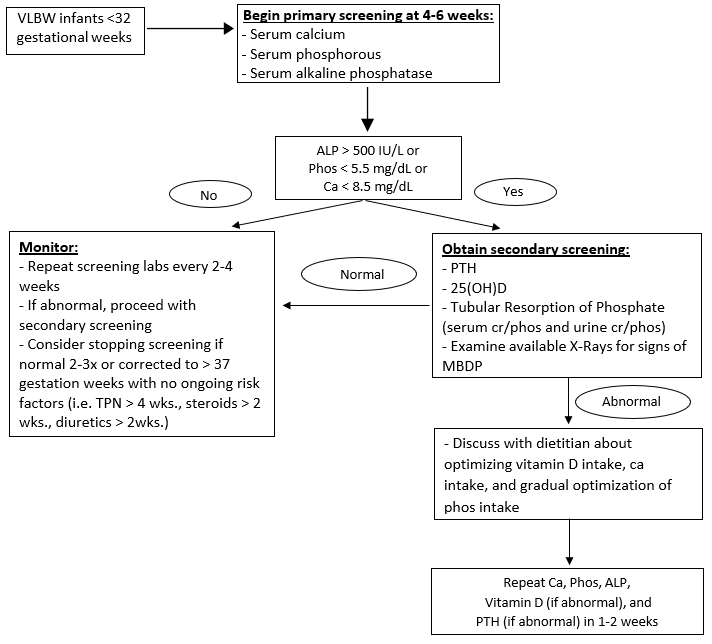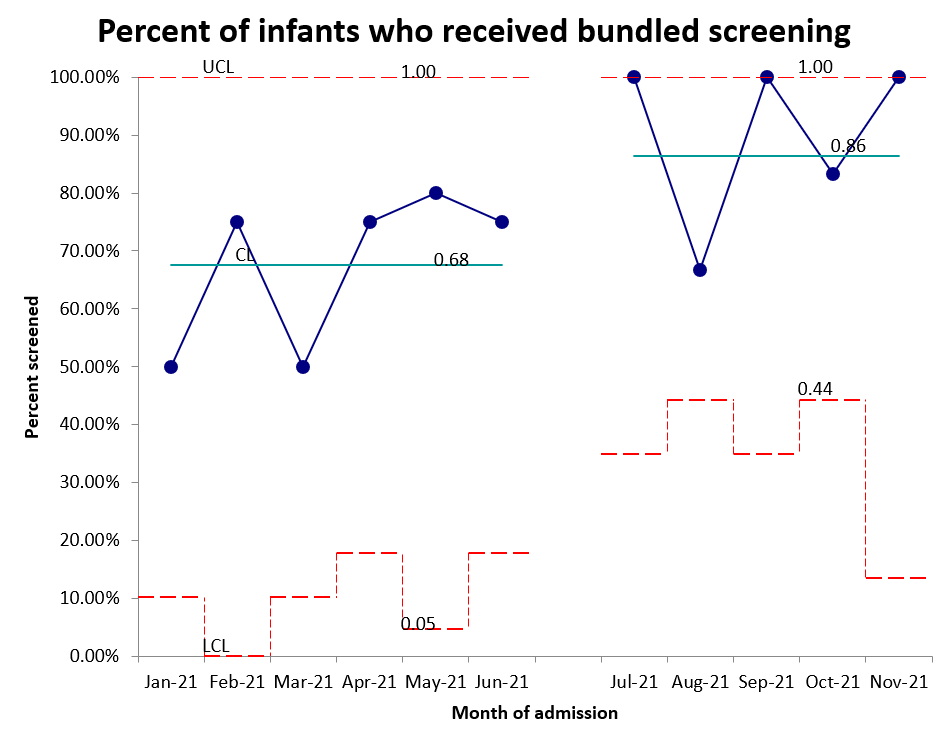Neonatal Quality Improvement
Category: Abstract Submission
Neonatal Quality Improvement III: GI and Nutrition
232 - A novel, interdisciplinary approach to screening for metabolic bone disease of prematurity
Friday, April 22, 2022
6:15 PM - 8:45 PM US MT
Poster Number: 232
Publication Number: 232.128
Publication Number: 232.128
Priya Creed, Indiana University Riley Hospital for Children, Indianapolis, IN, United States; Katie Huff, Indiana University School of Medicine, Indianapolis, IN, United States; Beatrice Stefanescu, Riley Hospital for Children at Indiana University Health, Indianapolis,, IN, United States
- PC
Priya V. Creed, MD (she/her/hers)
Fellow
Indiana University
Indianapolis, Indiana, United States
Presenting Author(s)
Background: Although the American Academy of Pediatrics published a consensus statement in 2013 highlighting the importance of timely diagnosis and treatment for metabolic bone disease of prematurity (MBDP), there still remains significant clinical practice variation in regards to when and which screening tests to obtain. The lack of appropriate MBDP screening with subsequent delay in treatment can result in adverse health implications such as postnatal growth failure and spontaneous fractures. A retrospective chart review of the last 31 very low birth weight infants discharged from our neonatal intensive care unit (NICU) in 2020 showed only 13% of these infants were appropriately screened. This compelling data shows a critical need for practice improvement for MBDP screening in our NICU.
Objective: To increase MBDP screening for all neonates born ≤32 gestational weeks and ≤1500 grams with a bundle of serum calcium, phosphorous, and alkaline phosphatase at 4-6 weeks of life to 90% by June 30, 2022.
Design/Methods: This is a pre-/post-intervention quasi-experimental design study with quality improvement (QI) methodology. We formed an interdisciplinary team consisting of neonatology faculty and fellows, advanced practice providers, and dieticians. The baseline period is between January 1, 2021 and June 30, 2021. A key intervention identified was the development and dissemination of a standardized, step-wise screening algorithm (Figure 1). This algorithm along with other interventions were implemented in July 2021 as part of our first Plan-Do-Study-Act (PDSA) cycle followed by subsequent reiterative cycles. Ongoing prospective chart review is being performed to determine our post-intervention screening rates.
Results: A total of 59 patients were analyzed which includes 37 patients in the baseline period and 22 patients in the post-intervention period. The baseline mean for the percentage of patients who received bundled screening is 68% (Figure 2). After starting this QI initiative, our screening rate has shown a trend toward improvement with a mean of 86%. Of 22 patients eligible for screening, 19 received the recommended primary screening labs with 6 (32%) patients having abnormal results (Figure 3).Conclusion(s): Our novel, interdisciplinary team-derived approach toward MBDP has preliminarily resulted in an improvement in MBDP screening. Of the patients screened, a significant number have abnormal results indicating MBDP. Identifying these patients allows for optimizing mineral intake before further progression of the disease. We plan to continue reiterative PDSA cycles to achieve our primary aim and sustainment.
Figure 1 Screening for metabolic bone disease of prematurity algorithm
Screening for metabolic bone disease of prematurity algorithm
Figure 2 Control chart showing the monthly percentage of patients screened with all three biomarkers
Control chart showing the monthly percentage of patients screened with all three biomarkers
Objective: To increase MBDP screening for all neonates born ≤32 gestational weeks and ≤1500 grams with a bundle of serum calcium, phosphorous, and alkaline phosphatase at 4-6 weeks of life to 90% by June 30, 2022.
Design/Methods: This is a pre-/post-intervention quasi-experimental design study with quality improvement (QI) methodology. We formed an interdisciplinary team consisting of neonatology faculty and fellows, advanced practice providers, and dieticians. The baseline period is between January 1, 2021 and June 30, 2021. A key intervention identified was the development and dissemination of a standardized, step-wise screening algorithm (Figure 1). This algorithm along with other interventions were implemented in July 2021 as part of our first Plan-Do-Study-Act (PDSA) cycle followed by subsequent reiterative cycles. Ongoing prospective chart review is being performed to determine our post-intervention screening rates.
Results: A total of 59 patients were analyzed which includes 37 patients in the baseline period and 22 patients in the post-intervention period. The baseline mean for the percentage of patients who received bundled screening is 68% (Figure 2). After starting this QI initiative, our screening rate has shown a trend toward improvement with a mean of 86%. Of 22 patients eligible for screening, 19 received the recommended primary screening labs with 6 (32%) patients having abnormal results (Figure 3).Conclusion(s): Our novel, interdisciplinary team-derived approach toward MBDP has preliminarily resulted in an improvement in MBDP screening. Of the patients screened, a significant number have abnormal results indicating MBDP. Identifying these patients allows for optimizing mineral intake before further progression of the disease. We plan to continue reiterative PDSA cycles to achieve our primary aim and sustainment.
Figure 1
 Screening for metabolic bone disease of prematurity algorithm
Screening for metabolic bone disease of prematurity algorithmFigure 2
 Control chart showing the monthly percentage of patients screened with all three biomarkers
Control chart showing the monthly percentage of patients screened with all three biomarkers